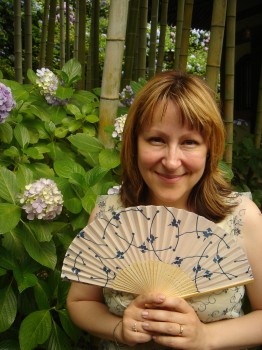Search results for "jarkko laine prize"
Leena Parkkinen: Galtbystä länteen [West from Galtby]
19 December 2013 | Mini reviews, Reviews
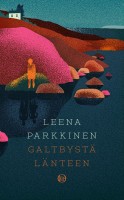 Galtbystä länteen
Galtbystä länteen
[West from Galtby]
Helsinki: Teos, 2013. 339 p.
ISBN 978-951-851-510-7
€32.90, hardback
Leena Parkkinen’s first novel, Sinun jälkeesi, Max (‘After you, Max’) was awarded the Helsingin Sanomat literature prize for best first work of 2009. Her new novel contains crime story ingredients, but the focus is on love between siblings, loss and the demand for truth. The story begins in 1947, after the war, on an island in the south-western Finnish archipelago. Sebastian, brother of Karen, has returned from the front; it’s time to mend the best clothes and dancing shoes. But to the horror of the island community, the body of a young girl is found on the shore, and Sebastian gets the blame. Sixty-five years later her brother’s fate has not left Karen alone, and she sets out to find the truth. Capable of handling different times, Parkkinen (born 1979) is also a skilful interpreter of conflicting sentiments, as unexpected twists develop towards the end.
Poems
31 March 1998 | Fiction, poetry
Agnosis IV
Set your altar up in the evening,
in the morning clear it away:
the wandering goes on. Don't persuade yourself
of anything, or anyone else:
fearful forces are epidemic,
no place is sacred
for long.
Again and again
the sacred
starts.
If you happen to be there
don't refuse to see.
a light wind
stirring a treetop:
a shoal of fish
in blue abyss
Markus Nummi: Karkkipäivä [Candy day]
26 November 2010 | Mini reviews, Reviews
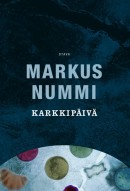 Karkkipäivä
Karkkipäivä
[Candy day]
Helsinki: Otava, 2010. 383 p.
ISBN 978-951-1-24574-2
€28, hardback
Like this one, Markus Nummi’s previous novel, Kiinalainen puutarha (‘Chinese garden’, 2004), set in Asia at the turn of the 20th century, involves a child’s perspective. Karkkipäivä‘s main theme, however, is a portrait of contemporary Finland. Tomi is a little boy whose alcoholic parents are incapable of looking after him; Mirja’s mother is a frantic workaholic heading for a nervous breakdown. She is a control freak who secretly gorges on chocolate at work and beats her little daughter – a grotesque portrait of contemporary womanhood. Tomi manages to get some adult attention and help from a writer; the relation between them gradually builds into one of trust. Katri is a social worker, empathetic but virtually helpless as part of the social services bureaucracy. Virtually every adult suspects others of lying, finding each other’s motives doubtful. Nummi (born 1959) has structured Karkkipäivä with great skill; the ending, in which matters are resolved almost by chance, is particularly gripping. This novel was nominated for the 2010 Finlandia Prize for Fiction.
Johanna Sinisalo: Enkelten verta [Angels’ blood]
2 February 2012 | Mini reviews, Reviews
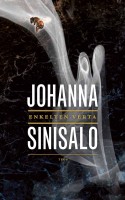 Enkelten verta
Enkelten verta
[Angels’ blood]
Helsinki: Teos, 2011. 274 p.
ISBN 978-951-851-414-8
€ 32, hardback
The literary career of Johanna Sinisalo (born 1958) has embraced fiction, drama, sci-fi and children’s books. Her 2000 Finlandia Fiction Prize-winning fantasy novel Ennen päivänlaskua ei voi and the novel Linnunaivot (2008) have been published in English as Not before Sundown and Birdbrain respectively. In this new novel, set in the near future, the central role is played by bees: widespread beehive failures in the United States and the resulting drop in pollination have resulted in an enormous food shortage that threatens the world economy. Orvo is a loner, the father of Eero, his grown-up son. Sinisalo cleverly works in animal rights activist Eero’s controversial blog comments on animal rights and modern man’s flawed relation to nature. However, this is also the novel’s biggest problem, as the blogging starts to weaken the story, of three generations of men in a family. Both the mythic, parallel reality of the bees and the tough-and-tender relationship between father and son are strong indications of Sinisalo’s narrative skill.
Translated by David McDuff
The miracle of the rose
30 June 1997 | Archives online, Fiction, Prose
Extracts from the novel Naurava neitsyt (‘The laughing virgin’, WSOY, 1996). The narrator in this first novel by Irja Rane is an elderly headmaster and clergyman in 1930s Germany. In his letters to his son, Mr Klein contemplates the present state of the world, hardly recovered from the previous war, his own incapacity for true intimacy – and tells his son the story of the laughing virgin, a legend he saw come alive. Naurava neitsyt won the Finlandia Prize for Fiction in 1996
28 August
My dear boy,
I received your letter yesterday at dinner. Let me just say that I was delighted to see it! For as I went to table I was not in the conciliatory frame of mind that is suitable in sitting down to enjoy the gifts of God. I was still fretting when Mademoiselle put her head through the serving hatch and said:
‘There is a letter for you, sir.’
‘Have I not said that I must not be disturbed,’ I growled. I was surprised myself at the abruptness of my voice.
‘By your leave, it is from Berlin,’ said Mademoiselle. ‘Perhaps it is from the young gentleman.’
‘Bring it here,’ I said. More…
Jarl Hellemann in memoriam 1920–2010
15 March 2010 | In the news
One of the grand old men of Finnish publishing, Jarl Hellemann, wrote in one of his own books: ‘Book publishing is by nature personified, a personal activity.
‘Most of the world’s old publishing houses still bear their founders’ names: Bonnier, Collins, Heinemann, Harper, Knopf, Bertelsmann, Werner Söderström, Gummerus. Americans ignorant of the exceptions to this rule among Finnish publishers still occasionally begin their letters, “Dear Mr Otava” or “Dear Mr Tammi”.’ (From Kustantajan näkökulma, ‘A publisher’s point of view’, Otava, published in Books from Finland 3/1999)
Hellemann himself was Mr Tammi for a long time; he started as a publishing editor at Tammi Publishing Company in 1945 and retired as managing director in 1982.
In 1955 he founded Keltainen kirjasto, the ‘Yellow Library’, an imprint of novels published since the First World War by prominent writers from all over the world. The first was Too Late the Phalarope by Alan Paton, the latest – published in 2009 – was The Disappeared by Kim Echlin. The series now contains more than 400 works, among them novels by 24 Nobel prize-winners.
Among the books in Keltainen kirjasto (list, in Finnish), Hellemann’s favourite was James Joyce’s Ulysses, translated by the poet and author Pentti Saarikoski in 1964. Hellemann continued choosing books for Keltainen kirjasto long after he retired.
Born in Copenhagen, Hellemann moved with his family to his mother’s home country, Finland, in the 1930s. Well-travelled and fluent in many languages, Hellemann himself published a novel (at the age of 25), three books on publishing and, in 1996, his memoirs.
New from the archives
19 February 2015 | This 'n' that
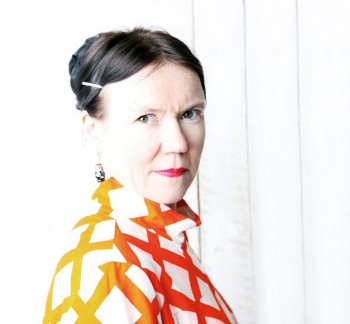
Rosa Liksom. Kuva: Pekka Mustonen
When the pseudonymous Rosa Liksom (born 1958; real name Anni Ylävaara) burst on the Finnish literary scene in 1985 with her first book, Yhden yön pysäkki (‘One night stand’), excitement was intense. For a start, she managed to keep her real identity secret, even when she appeared at public events and book-signings; then, she wrote generally in her native northern Finnish dialect, which hadn’t previously been heard very much in literary circles. Her very short short prose charted landscapes also not much represented in literature – the far north, the uneducated, the dispossessed.
This group of seven stories, from her second book, Tyhjän tien paratiisit (‘Paradises of the open road’, 1989), cover territory which has become familiar in her work: a woman who marries a layabout, a bellicose butcher’s son, a cleanliness fanatic for whom hygiene is more important than human relationships….
Rosa Liksom won the Finlandia Prize in 2011 for Hytti nro 6, which was published by Serpent’s Tail, London, in a translation by Lola Rogers last year.
*
The digitisation of Books from Finland continues apace, with a total of 360 articles and book extracts made available online so far. Each week, we bring a newly digitised text to your attention.
Christmas best-sellers in Finnish fiction
13 January 2012 | In the news

Rosa Liksom. Photo: Pekka Mustonen
Most new Finnish books are printed and sold in the autumn, and sales pick up considerably in December. The number one on the December list link: in Finnish only) of best-selling fiction titles in Finland, compiled by the Finnish Booksellers’ Association, is the Finlandia Fiction Prize-winning novel Hytti nro 6 (‘Compartment number 6’, WSOY, 2011) by Rosa Liksom (this is her homepage, also in English).
The Finlandia winner was announced on 1 December, upon which the book shot – from nowhere – to the top of the list.
Laila Hirvisaari’s historical novel, Minä Katariina (‘I, Catherine’, Otava), climbed up from the third place to the second. Number three was a newcomer, a tragic love story entitled Kätilö (‘The midwife’, WSOY), by Katja Kettu, set in the last phase of the Finnish Continuation War (1941–1944).
Jari Tervo’s Layla (WSOY) was in fourth place, while November’s number one, Ilkka Remes’s thriller Teräsleijona (‘Steel lion’, WSOY), came fifth.
In November Tuomas Kyrö occupied both the fourth and the tenth place with his novels Kerjäläinen ja jänis (‘The beggar and the hare’, Siltala – a pastiche-style story inspired by Jäniksen vuosi / The Year of the Hare by Arto Paasilinna, 1975) and Mielensäpahoittaja (‘Taking offence’, WSOY, 2010). In December they were numbers six and seven, in reverse order.
Graphic success
10 May 2012 | In the news
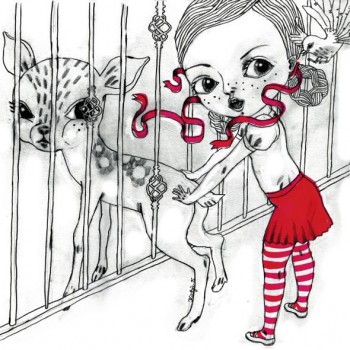
Finnish Comics Annual: picture by Katja Tukiainen
The 2012 Finnish Comics Annual, edited by Reija Sann, was published in May by HuudaHuuda and the Finnish Comics Association. The book focuses on everyday realism, featuring eleven artists: Terhi Ekebom, Grönroos & Rantio, Matti Hagelberg, Pauli Kallio, Tarmo Koivisto, Mika Lietzen, Petteri Tikkanen, Tiitu Takalo, Katja Tukiainen and Riitta Uusitalo. In their work the limits of the individual and the collective, the local and the universally human are explored by means of fantasy.
The first Finnish Comics Annual, featuring Finnish comics and graphic novels in English, was published last year. The editor was Ville Hänninen.
This year’s Finlandia Comics Prize, worth €5,000, awarded by the association Tampere Kuplii (‘Tampere bubbles’) at a comics festival of the same name in Tampere on 4 May, went to graphic designer and illustrator Ville Tietäväinen for his voluminous graphic novel Näkymättömät kädet (‘Invisible hands’, WSOY, 2011). Ten finalists were chosen by a jury out of 68 candidates, and the final choice was made by actor Armi Toivanen.
Näkymättömät kädet is the story of a Moroccan tailor, Rashid, who loses his job and has to leave his family to look for work in Europe. For an illegal alien life in Spain is unbearably difficult. Introducing the work in the article ‘Funny peculiar’ (there is also a sample from Tietäväinen’s work) Heikki Jokinen comments: ‘Through the story of one person, Tietäväinen speaks of important matters: poverty, human value and what keeps us going, hope.’


